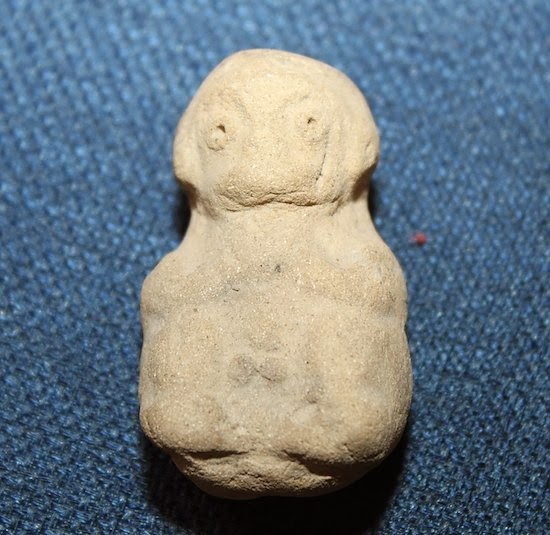



consulate New Haven [Credit: Ecuador Consulate'New Haven Independent]
In October of 2012, the nameless woman (she asked her identity be kept private) arrived at the consulate unannounced and without an appointment, asking to see the general consul. She showed Erazo the cardboard container she’d brought, which had held a pair of Skechers Sport Fusion sneakers. Inside were four ceramic artifacts, each now thought to be more than 1,000 years old.
The woman seemed visibly upset and eager to give the objects to someone who knew where they had come from and belonged, Erazo said.
At first glance, the pottery clearly appeared to him to be from his country, and from another time.
Delicate terra cotta patterns—of concentric circles, parallel lines and polygons—covered the largest bowl. Two smaller figurines resembled people, with recognizable, stylized faces and body parts. A carved snake coiled itself around the opening of the last vessel, its little head coming to rest on its body, two notched eyes staring out in opposite directions.
The larger objects looked to be glazed or painted, while the smaller artifacts were made of partially eroded clay the color of papier-mache, with corrosion obscuring the details of their workmanship.
Erazo thanked the woman and accepted the loot. (The woman is Cuban-American, though she said she preferred her identity stay unknown.)
The gift-giver said she had found the relics in her house in New Haven. She didn’t know any more about their origins or how long they had been there.
“I believe she had read about the recovery of Peruvian artifacts, and that’s what motivated her to come forward,” Erazo said.
After Peru’s government filed a lawsuit against Yale in 2008, the university promised to return thousands of antiquities to the country – including jewelry, pottery, stone tools and human bones – by the end of 2012.
Local and national press covered the drawn-out legal battle, which was resolved after alumni strongly encouraged their alma mater to give back the goods. The art and relics are now on display at the Inca site of Machu Picchu, nestled in the Andes.
Now, these Ecuadorian artifacts will make a similar journey back to their country of origin.
Erazo consulted Yale anthropology professor Richard Burger for help in learning more about the objects that had been laid at his doorstep, provenance unknown. Burger oversaw the Peruvian collection for nearly three decades while it was housed in Yale’s Peabody Museum.
“In archaeology, the best situation is when you excavate something scientifically and you can date it using radiocarbon dating or some other technique,” Burger said. “But when something has been looted and gone on the black market, so it’s completely disassociated from its original place of encounter, it’s more difficult.”
Since the mysterious objects lacked a back story, Erazo and Burger speculated that a relative had bought them from a dealer as souvenirs while visiting Ecuador. Merchants sometimes buy up antiquities and sell them to tourists cheaply, and they end up being passed down to relatives who know nothing of their value.
Burger was able to date and identify the ceramics based on their style.
“You could look at a car and say, well, that car comes from the 1950’s and it’s an Oldsmobile because it has those big tail-fins, a particular kind of grill and it’s a color that people don’t use any more,” he said. “In the same way, in archaeology, there’s the ability to link the style of these looted objects to places where people have excavated and documented the materials.”
The shape of the pedestal base on one vessel helped Burger place it as originating from the northernmost highlands of Ecuador. The decoration – called “resist” or “negative” – was also distinctive. It pointed toward a pre-Hispanic era when a number of craftsmen in Ecuador and Colombia, across the border, favored that style: between 500 and 850 A.D. (“Some colleagues might favor a somewhat later estimate,” Burger qualified.)
In negative decoration, the artisan paints a piece of pottery with clay slip after the work has been fired. The pottery is next covered with an organic solution and heated, so the solution turns dark or blackens. Where the pottery was painted with slip, the solution doesn’t stick, so a “reverse” or “negative” design emerges.
Since both bowls were complete, unbroken pieces, Burger concluded that they were probably used in burial contexts – personal possessions of the dead, either used in their lifetime or for use in the next life. They may have held food at a funeral.
Burger estimated that the two pots are roughly the same age, while the fragments look several centuries older and may have come from a different location.
Thursday, Erazo plans to fly with the pieces back to Ecuador, where they will be repatriated and most likely placed in a museum.
“I think there’s some sentiment that these things are best kept in their point of origin, their home countries, and that perhaps the people will appreciate them in a way there that they’re not appreciated here,” Burger said.
Erazo hasn’t had contact with the woman who discovered the objects since she handed them over out of the blue last fall.
“I hope she reads that they are heading home and this helps her feel better,” he said.
Author: Cora Lewis | Source: New Haven Independent [December 12, 2013]